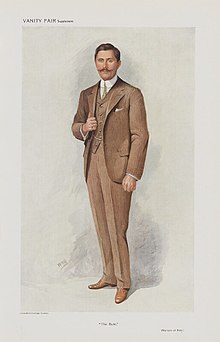John Crichton-Stuart, 4th Marquess of Bute, KT (20 June 1881 – 25 April 1947), was a Scottish peer.[1]
The Marquess of Bute | |
|---|---|
 The 4th Marquess of Bute, c. 1915 | |
| Personal details | |
| Born | 20 June 1881 Chiswick, London, England |
| Died | 25 April 1947 (aged 65) |
| Spouse | |
| Children | Lady Mary Walker John Crichton-Stuart, 5th Marquess of Bute Lady Jean Bertie Lord Robert Crichton-Stuart Lord David Crichton-Stuart Lord Patrick Crichton-Stuart Lord Rhidian Crichton-Stuart |
| Parent(s) | John Crichton-Stuart, 3rd Marquess of Bute Hon. Gwendolen Fitzalan-Howard |
| Alma mater | Harrow School |

Biography
editBute was born at Chiswick House in Chiswick, London. He was the son of John Crichton-Stuart, 3rd Marquess of Bute and Gwendolen Fitzalan-Howard, a daughter of Edward Fitzalan-Howard, 1st Baron Howard of Glossop and granddaughter of Henry Howard, 13th Duke of Norfolk.
He was educated at Harrow School, and succeeded his father as Marquess of Bute in October 1900, when he was nineteen years old. In early 1902 he was on a tour in the Far East. On reaching his majority in June 1902, he received the Honorary Freedom of the Burgh of Rothesay,[2] and later the same month took the oath and his seat in the House of Lords.[3] The 4th marquess, like his father, was a Knight of the Thistle.[1]
He also had a passion for architecture and was responsible for restoring Caerphilly Castle in South Wales.[4] In 1936 he published a pamphlet entitled "A Plea for Scotland's Architectural Heritage", which argued for the preservation of Scotland's smaller burgh dwellings and advocated reconditioning traditional working class housing, rather than wholesale demolition.[5] He became "the man who sold a city" when, in 1938, he disposed of the remaining Bute family estate in Cardiff.[4]
Bute House
editBetween 1903 and 1930, Bute bought and renovated a number of houses, No.s 5, 6, 7 and 8, in Charlotte Square in Edinburgh, making No.5 his townhouse. In 1949 his heir, the 5th marquess, moved his family to No.6 and placed No.5 on loan to the National Trust for Scotland.[6] In 1956, on his death, No.s 5, 6 and 7 were given permanently to the Trust in lieu of death duties.[7] No.6, Bute House, became the official residence of the Secretary of State for Scotland and is now the official residence of the First Minister of Scotland.[8] In the 21st century, revelations by Antony Beevor, in his study of the Spanish Civil War, The Battle for Spain, that the 4th Marquess, a Roman Catholic, had donated the proceeds from the sale of the estate's properties in Cardiff to help finance the regime change war by General Franco's Nationalist faction.[9] While this was done as a reaction to both the Red Terror and the religious persecution the Second Spanish Republic had unleashed against the Catholic Church in Spain, the revelation caused the 4th Marquess to be posthumously accused of Fascism and led to unsuccessful demands to the National Trust for Scotland for the renaming of Bute House.[10]
Family life
editOn 6 July 1905, the young Lord Bute married Augusta Bellingham, daughter of Sir (Alan) Henry Bellingham, 4th Baronet, and Catherine Noel. The lavish Roman Catholic Wedding Mass, at Bellingham Castle in the village of Castlebellingham in County Louth, Ireland, was followed by a party at Mount Stuart House in Scotland. A film company was employed to film the event, one of the earliest examples of the aristocratic classes making a private film.[11]
They had seven children:
- Lady Mary Crichton-Stuart (8 May 1906 – 1980); married Edward Walker and had issue.
- John Crichton-Stuart, 5th Marquess of Bute (4 August 1907 – 14 August 1956)
- Lady Jean Crichton-Stuart (28 October 1908 – 23 October 1995); married Lt.-Cmdr. Hon. James Bertie and had issue (two sons); her elder son was Fra' Andrew Willoughby Ninian Bertie, Prince and Grand Master of the Sovereign Military Order of Malta from 1988 until his death in 2008.
- Lord Robert Crichton-Stuart (12 December 1909 – 26 June 1976); married Lady Janet Egida Montgomerie (1911–1999), daughter of Archibald Montgomerie, 16th Earl of Eglinton and had issue.
- Lord David Crichton-Stuart (8 February 1911 – 3 March 1970); married Ursula Packe and had issue.
- Lord Patrick Crichton-Stuart (1 February 1913 – 5 February 1956); married Jane von Bahr and had issue.
- Captain Lord Rhidian Crichton-Stuart (4 June 1917 – 25 June 1969); married Selina Gerth van Wijk and had issue.
Ancestry
editReferences
edit- ^ a b Sir William Llewelyn Davies (1959). "BUTE, marquesses of Bute, Cardiff Castle, etc". biography.wales.
- ^ "Court Circular". The Times. No. 36800. London. 21 June 1902. p. 8.
- ^ "Parliament – House of Lords". The Times. No. 36803. London. 25 June 1902. p. 6.
- ^ a b "Bute Family Timeline 1900 –". ButeFamily.com. Archived from the original on 27 September 2020. Retrieved 10 December 2015.
- ^ Glendinning, MacInnes & MacKechnie 1996, pp. 423–424.
- ^ "5 Charlotte Square". Edinburgh World Heritage. Retrieved 8 September 2023.
- ^ Burnet 2017, p. 7.
- ^ Burnet 2017, Introduction.
- ^ Beevor 2006, p. 155.
- ^ "Campaigners seek Bute House name change over fascism link claims". The Scotsman. 30 June 2016. Retrieved 8 September 2023.
- ^ "Wedding of The 4th Marquess of Bute 1905, the". National Library of Scotland. Retrieved 10 December 2015.
Sources
edit- Beevor, Antony (2006) [1982]. The Battle for Spain: The Spanish Civil War 1936–1939. London: Weidenfeld & Nicolson. ISBN 0297848321.
- Burnet (2017). Bute House (PDF). Edinburgh: National Trust for Scotland.
- Glendinning, Miles; MacInnes, Ranald; MacKechnie, Aonghus (1996). A History of Scottish Architecture: From the Renaissance to the Present Day. Edinburgh: Edinburgh University Press. ISBN 0-7486-0741-2.